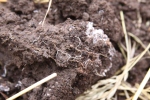Improving Soil
Good soil structure is paramount to a successful garden and is the first (earlier the better) place you should start when planning and preparing a garden. Tilth refers to the physical condition of the soil, good soil tilth is loose and friable to a depth that allows for good root penetration and proper drainage. Water shouldn’t stand for long in the garden nor should it run out immediately, proper drainage is a balance of the two extremes. Good soil should also be porous (small spaces for air) and resistant to compaction.
Soil is generally categorized as sandy, loamy, or clayey, the higher percentage of loam you have in your soil is generally better. Digging one spade deep into the ground and inspecting the soil when it is slightly moist (you should never work the soil when it is soaking wet or bone dry, it is not fun and it destroys the soil structure) should give you a good idea of what type of soil you have in various parts of your property. Obviously, you should select the sight with the best soil, proper drainage, and 8 plus hours of sun a day, but sometimes we don’t have this trifecta of garden heaven and we have to take matters into our own hands-soil amendment at our selected sight or existing garden spot.
If you have sandy soil and plan on planting something other than drought tolerant plants that like excellent drainage such as: rosemary, sunflowers, and succulents adding organic matter will make your soil more loamy and retain moisture. Loamy soils need to be maintained over the years, add back as much or more of what you take out, leaving the earth better than when you started. Clayey soil needs greensand, regular sand, and organic matter to break up the clay and improve drainage. Clay soil also needs a load of topsoil to give you working soil in your lifetime (don’t break your back or wallet on clay soil). Barnyard manure (rabbit, cow, and chicken being my personal favorites) that is mixed with natural bedding such as straw is your top choice; it adds moisture retaining properties, nutrients, and microbes that bring your soil to life in each smelly shovelful. Add manure that is well-rotted or add it in winter time at least 2 months before planting. Other soil amendments that give your soil proper drainage and aeration are coffee grounds, peat moss, coco coir, kitchen scraps (egg shells, fruit, and vegetable peelings), rice hulls, cotton burr compost (or any other compost), green cover crops, chopped leaf mold, bark, and sawdust (except walnut or cherry). All of these things should be generously added to all types of soil to keep up with the demands of vegetable gardening for proper tilth, microbial life, and nutrients, eliminating the need for harsh synthetic fertilizers.
These amendments can be added in by double digging for poor soils or gently incorporated with a hoe or other garden tool if your soil isn’t compacted. Moderate use of a tiller or tractor can be used, being careful not to overwork the soil and destroy the very tilth you are trying to build. Also work the soil when it is moist like a sponge, if it forms mud, frozen or is very dusty wait another day.
To preserve your hard work try to have designated walking areas and stay out of the root zone/planting area. Add a 2-6 inch mulch to suppress weeds, moderate soil temperature, retain moisture and prevent erosion. Watch for slugs and root rot on susceptible plants. Pull the mulch back around the base of plants if you start to notice any root rot or pest problems hiding in your mulch. Heavy rains will erode and compact bare soils as well. Many things work as mulch, my preferred combination is cardboard or black and white newspaper, well rotted manure, then straw or bark mulch on top. This slowly breaks down and adds to the soil.
With these practices put into place year-round you can have 10-18 inches of earthy, chocolate-colored, workable dirt in as little as one season without further damaging our earth or watersheds, and your bountiful garden will be your reward.
Garden soil with visible mycorrhizae strands and various organic matter.
On the subject of topsoil creation- “It takes these processes perhaps 500 years to make one inch of soil, but man with his destructive farming practices can destroy an inch in only a few years.” -Organic Farming and Gardening Magazine-


I called those people you recommended for the soil and they delivered a load this weekend. Great soil. I can’t wait to get my hands in the dirt!
A load of Phipp’s Topsoil can even remedy a pile of rocks!